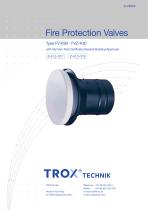
- Products
- Catalogs
- News & Trends
- Exhibitions
Sheet metal ventilation aperture silencer CA mineral wool


Add to favorites
Compare this product
Characteristics
- Material
- sheet metal, mineral wool
Description
FOR THE REDUCTION OF NOISE IN CIRCULAR DUCTS, GALVANISED SHEET STEEL CONSTRUCTION
Circular silencers Type CA for the reduction of noise in the circular ducts of air conditioning systems
Absorption material is non-combustible mineral wool with RAL quality mark, biosoluble and hence hygienically safe according to the German TRGS 905 (Technical Rules for Hazardous Substances) and EU directive 97/69/EC
Mineral wool faced with non-woven glass fibre as protection against erosion due to airflow velocities up to 20 m/s
Casing and perforated inner duct are galvanised sheet steel
Variant with spigot has a groove for a lip seal, suitable for circular connecting ducts to EN 1506 or EN 13180
Insertion loss measured according to ISO 7235
Casing air leakage to EN 15727, class B
Optional equipment and accessories
With flanges on both ends
With lip seals on both ends
Application
Circular silencers Type CA for the reduction of noise in the circular ducts of air conditioning systems
For the reduction of air-regenerated noise of air terminal units such as LVC and TVR, and of mechanical self-powered controllers such as RN and VFC
For the reduction of fan noise
Can be used as cross talk silencer to reduce the transfer of noise through ducts between neighbouring rooms
Special features
Insertion loss measured according to ISO 7235
Absorption material is non-combustible
Insulation thickness 50 mm or 100 mm
Nominal sizes
100, 125, 160, 200, 250, 315, 400, 450, 500, 560, 630, 710, 800 mm
For VAV terminal units and CAV controllers
100, 125, 160, 200, 250, 315, 400 mm
Catalogs
Related Searches
- Air grating
- Metal ventilation grill
- Rectangular air grating
- Displacement air diffuser
- Aluminium ventilation grill
- Square ventilation grill
- Ceiling displacement air diffuser
- Air handling unit
- Air filter
- Circular air diffuser
- Square displacement air diffuser
- Ventilation damper
- Commercial air handling unit
- Adjustable ventilation grill
- Standard air filter
- Metal ventilation damper
- Heat exchanger
- Linear air diffuser
- Slot air diffuser
- Jet nozzle
*Prices are pre-tax. They exclude delivery charges and customs duties and do not include additional charges for installation or activation options. Prices are indicative only and may vary by country, with changes to the cost of raw materials and exchange rates.









